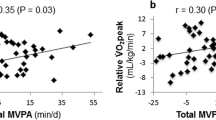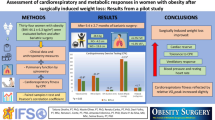Abstract
Background
We have previously shown promising results 2 years after Roux-en-Y gastric bypass surgery, within the Adolescence Morbid Obesity Surgery study (AMOS). The aim of the current study was to describe the 2-year outcome in cardiorespiratory fitness, body composition, and functional capacity in the Stockholm subset of the AMOS study.
Methods
Forty-one adolescents (10 male, 31 female, age 14–18 years, body mass index 35–69 kg·m−2) were included. In addition to anthropometric measurements, participants performed a submaximal bicycle test, 6-min walk test, dual-energy X-ray absorptiometry, and a short interview at baseline, 1 and 2 years after surgery.
Results
Relative improvements in maximal oxygen consumption (VO2max) per kilogram body mass (+62 %) and per kilogram fat-free mass (+21 %), as well as walking distance (+13 %) were observed after 1 year, and persisted 2 years after surgery. Despite a reduction of fat-free mass (−15 %), absolute VO2max was maintained across the full group (+8 %, p = ns) and significantly increased in non-smokers. Body mass and fat mass were significantly decreased (−45.4 and −33.3 kg, respectively). Self-reported physical activity was significantly increased, and pain associated with movement was reduced.
Conclusions
In adolescents with obesity, Roux-en-Y gastric bypass improved VO2max more than could be explained by fat mass loss alone. In combination with improved functional capacity and body composition, these results suggest that surgery in adolescence might add specific benefits of importance for future health.


Similar content being viewed by others
References
Daniels SR. The consequences of childhood overweight and obesity. Futur Child 2006 Spring;16(1):47–67.
Danielsson P, Kowalski J, Ekblom O, Marcus C. Response of severely obese children and adolescents to behavioral treatment. Arch Pediatr Adolesc Med 2012 Dec;166(12):1103–1108.
Karlsson J, Taft C, Ryden A, Sjostrom L, Sullivan M. Ten-year trends in health-related quality of life after surgical and conventional treatment for severe obesity: the SOS intervention study. Int J Obes. 2007 Aug;31(8):1248–1261.
Sjostrom L. Review of the key results from the Swedish obese subjects (SOS) trial—a prospective controlled intervention study of bariatric surgery. J Intern Med 2013 Mar;273(3):219–234.
Puzziferri N, Roshek TB, 3rd, Mayo HG, Gallagher R, Belle SH, Livingston EH. Long-term follow-up after bariatric surgery: a systematic review. JAMA 2014 Sep 3;312(9):934–942.
Warburton DE, Nicol CW, Bredin SS. Health benefits of physical activity: the evidence. CMAJ 2006 Mar 14;174(6):801–809.
Lavie CJ, De Schutter A, Milani RV. Healthy obese versus unhealthy lean: the obesity paradox. Nat Rev Endocrinol 2014 Sep 30;11(1):55–62.
DeFina LF, Haskell WL, Willis BL, Barlow CE, Finley CE, Levine BD, et al. Physical activity versus cardiorespiratory fitness: two (partly) distinct components of cardiovascular health? Prog Cardiovasc Dis 2015 Jan-Feb;57(4):324–329.
Blair SN, Brodney S. Effects of physical inactivity and obesity on morbidity and mortality: current evidence and research issues. Med Sci Sports Exerc 1999 Nov;31(11 Suppl):S646–S662.
Stegen S, Derave W, Calders P, Van Laethem C, Pattyn P. Physical fitness in morbidly obese patients: effect of gastric bypass surgery and exercise training. Obes Surg 2011 Jan;21(1):61–70.
de Souza SA, Faintuch J, Sant'anna AF. Effect of weight loss on aerobic capacity in patients with severe obesity before and after bariatric surgery. Obes Surg 2010 Jul;20(7):871–875.
Wilms B, Ernst B, Thurnheer M, Weisser B, Schultes B. Differential changes in exercise performance after massive weight loss induced by bariatric surgery. Obes Surg 2013 Mar;23(3):365–371.
Seres L, Lopez-Ayerbe J, Coll R, Rodriguez O, Vila J, Formiguera X, et al. Increased exercise capacity after surgically induced weight loss in morbid obesity. Obesity (Silver Spring). 2006 Feb;14(2):273–279.
International Pediatric Endosurgery G. IPEG guidelines for surgical treatment of extremely obese adolescents. J Laparoendosc Adv Surg Tech A. 2009 Apr;19 Suppl 1:xiv-xvi.
Black JA, White B, Viner RM, Simmons RK. Bariatric surgery for obese children and adolescents: a systematic review and meta-analysis. Obes Rev 2013 Aug;14(8):634–644.
Olbers T, Gronowitz E, Werling M, Marlid S, Flodmark CE, Peltonen M, et al. Two-year outcome of laparoscopic Roux-en-Y gastric bypass in adolescents with severe obesity: results from a Swedish Nationwide study (AMOS). Int J Obes. 2012 Nov;36(11):1388–1395.
Jarvholm K, Olbers T, Marcus C, Marild S, Gronowitz E, Friberg P, et al. Short-term psychological outcomes in severely obese adolescents after bariatric surgery. Obesity (Silver Spring). 2012 Feb;20(2):318–323.
Paulus GF, de Vaan LE, Verdam FJ, Bouvy ND, Ambergen TA, van Heurn LW. Bariatric surgery in morbidly obese adolescents: a systematic review and meta-analysis. Obes Surg 2015 May;25(5):860–878.
Inge TH, Courcoulas AP, Jenkins TM, Michalsky MP, Helmrath MA, Brandt ML, et al. Weight loss and health status 3 years after bariatric surgery in adolescents. N Engl J Med. 2016 Jan;14;374(2):113–123.
Astrand I. Aerobic work capacity in men and women with special reference to age. Acta Physiol Scand Suppl. 1960;49(169):1–92.
Morinder G, Mattsson E, Sollander C, Marcus C, Larsson UE. Six-minute walk test in obese children and adolescents: reproducibility and validity. Physiother Res Int 2009 Jun;14(2):91–104.
World Health Organisation [Internet]. Global recommendations on physical activity for health. [cited 25 Nov 2015]; Available from: http://apps.who.int/iris/bitstream/10665/44399/1/9789241599979_eng.pdf.
Pescatello LS. American College of Sports M. ACSM's guidelines for exercise testing and prescription. Philadelphia: Wolters Kluwer/Lippincott Williams & Wilkins Health; 2014.
de Souza SA, Faintuch J, Fabris SM, Nampo FK, Luz C, Fabio TL, et al. Six-minute walk test: functional capacity of severely obese before and after bariatric surgery. Surg Obes Relat Dis 2009 Sep-Oct;5(5):540–543.
Maniscalco M, Zedda A, Giardiello C, Faraone S, Cerbone MR, Cristiano S, et al. Effect of bariatric surgery on the six-minute walk test in severe uncomplicated obesity. Obes Surg 2006 Jul;16(7):836–841.
da Silva RP, Martinez D, Faria CC, de Carli LA, de Souza WI, Meinhardt NG, et al. Improvement of exercise capacity and peripheral metaboreflex after bariatric surgery. Obes Surg 2013 Nov;23(11):1835–1841.
Sallis JF. Epidemiology of physical-activity and fitness in children and adolescents. Crit Rev Food Sci Nutr. 1993;33(4–5):403–8.
Chaston TB, Dixon JB, O'Brien PE. Changes in fat-free mass during significant weight loss: a systematic review. Int J Obes. 2007 May;31(5):743–750.
Wagner PD. New ideas on limitations to VO2max. Exerc Sport Sci Rev 2000 Jan;28(1):10–14.
Hsuan CF, Huang CK, Lin JW, Lin LC, Lee TL, Tai CM, et al. The effect of surgical weight reduction on left ventricular structure and function in severe obesity. Obesity (Silver Spring). 2010 Jun;18(6):1188–1193.
Vijgen GH, Bouvy ND, Hoeks J, Wijers S, Schrauwen P, van Marken Lichtenbelt WD. Impaired skeletal muscle mitochondrial function in morbidly obese patients is normalized one year after bariatric surgery. Surg Obes Relat Dis 2013 Nov-Dec;9(6):936–941.
Thomas PS, Cowen ER, Hulands G, Milledge JS. Respiratory function in the morbidly obese before and after weight loss. Thorax 1989 May;44(5):382–386.
American College of Sports Medicine Position Stand. The recommended quantity and quality of exercise for developing and maintaining cardiorespiratory and muscular fitness, and flexibility in healthy adults. Med Sci Sports Exerc 1998 Jun;30(6):975–991.
Jacobi D, Ciangura C, Couet C, Oppert JM. Physical activity and weight loss following bariatric surgery. Obes Rev 2011 May;12(5):366–377.
King WC, Hsu JY, Belle SH, Courcoulas AP, Eid GM, Flum DR, et al. Pre- to postoperative changes in physical activity: report from the longitudinal assessment of bariatric surgery-2 (LABS-2). Surg Obes Relat Dis 2012 Sep-Oct;8(5):522–532.
Bond DS, Jakicic JM, Unick JL, Vithiananthan S, Pohl D, Roye GD, et al. Pre- to postoperative physical activity changes in bariatric surgery patients: self report vs. objective measures. Obesity (Silver Spring). 2010 Dec;18(12):2395–2397.
Ramirez-Marrero FA, Miles J, Joyner MJ, Curry TB. Self-reported and objective physical activity in postgastric bypass surgery, obese and lean adults: association with body composition and cardiorespiratory fitness. J Phys Act Health 2014 Jan;11(1):145–151.
Gill RS, Al-Adra DP, Shi X, Sharma AM, Birch DW, Karmali S. The benefits of bariatric surgery in obese patients with hip and knee osteoarthritis: a systematic review. Obes Rev 2011 Dec;12(12):1083–1089.
Ilieva EM, Oral A, Kucukdeveci AA, Varela E, Valero R, Berteanu M, et al. Osteoarthritis. The role of physical and rehabilitation medicine physicians. The European perspective based on the best evidence. A paper by the UEMS-PRM section professional practice committee. Eur J Phys Rehabil Med 2013 Aug;49(4):579–593.
Acknowledgments
We would like to thank the staff at National Childhood Obesity Center in Stockholm for their collection of data.
Author information
Authors and Affiliations
Corresponding author
Ethics declarations
The AMOS study was ethically approved by the regional ethical review board in Gothenburg (523–04) and conducted in accordance with the Declaration of Helsinki.
Grants and Funding
The project has received financial support from the Swedish Research Council, the Swedish Heart and Lung Foundation, the Swedish Order of Freemasons, and HRH Crown Princess Lovisa’s Foundation. Funding organizations had no involvement in the design or conduct of the present study.
Conflict of Interest
Authors declare no conflict of interest to the submitted work. Dr. Olbers reports personal fees and non-financial support from Johnson & Johnson, grants from Johnson & Johnson, outside the submitted work.
Informed Consent
Informed consent was obtained from all individual participants included in the study.
Rights and permissions
About this article
Cite this article
Brissman, M., Ekbom, K., Hagman, E. et al. Physical Fitness and Body Composition Two Years after Roux-En-Y Gastric Bypass in Adolescents. OBES SURG 27, 330–337 (2017). https://doi.org/10.1007/s11695-016-2282-1
Published:
Issue Date:
DOI: https://doi.org/10.1007/s11695-016-2282-1




